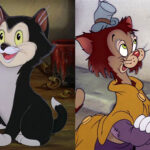Fluffy felines are undeniably adorable, but have you ever considered the sleek elegance of a Hairless Cat? These captivating creatures, with their distinctive appearance, are gaining popularity as beloved pets. While some may be drawn to the traditional image of a furry cat, hairless breeds offer a unique and often misunderstood charm. These felines, sometimes referred to as “naked cats,” are not entirely without fur; many possess a soft, downy coat that feels like warm suede. However, their minimal or absent fur does mean they require specific care to thrive.
Despite their seemingly low-maintenance look, hairless cats need dedicated grooming and protection from environmental extremes like sun and cold. But for those who fall in love with their striking looks and affectionate personalities, the extra care is a rewarding part of the bond. Let’s explore six fascinating hairless cat breeds that might just steal your heart.
Exploring Different Hairless Cat Breeds
1. Sphynx: The Original Hairless Wonder
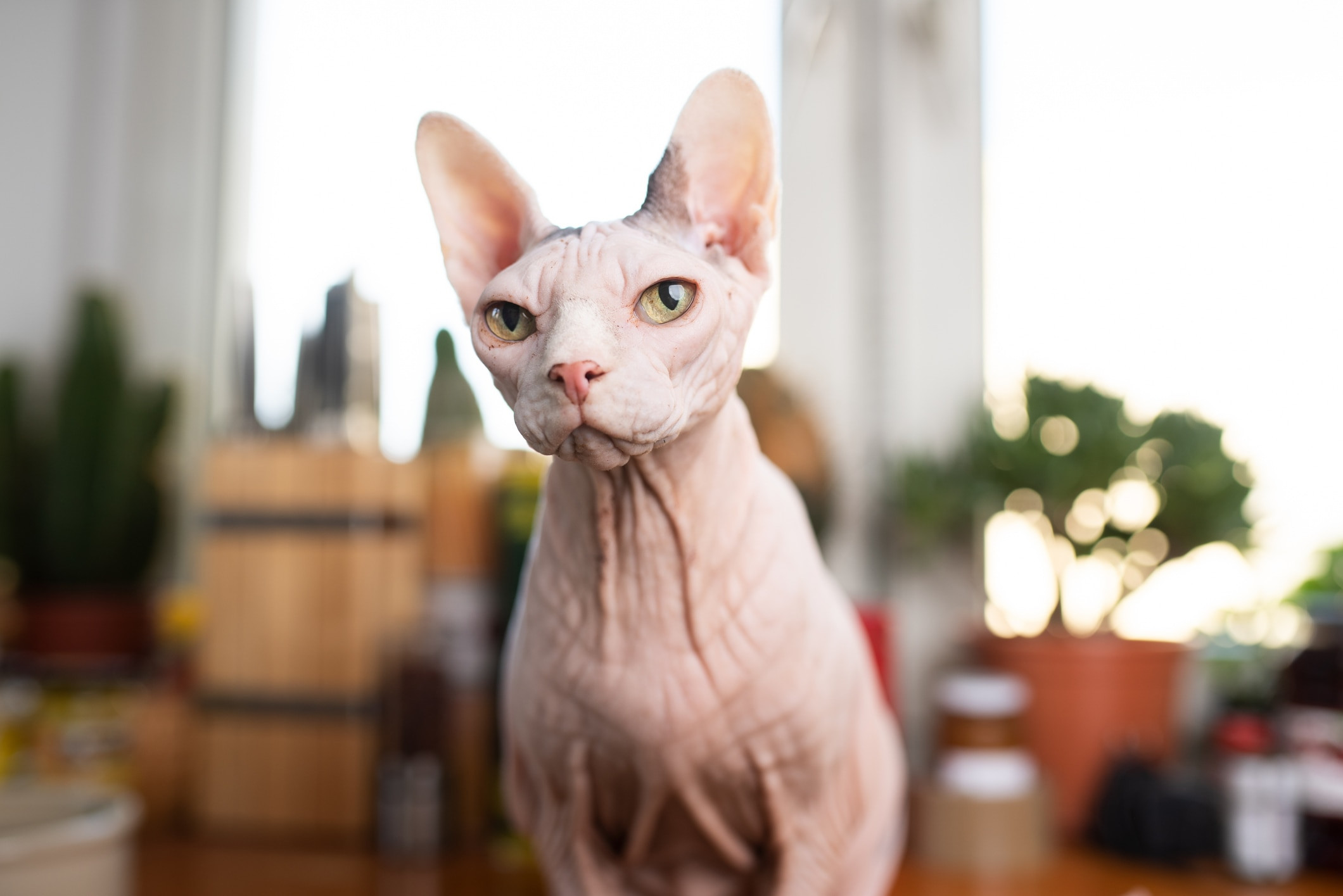 pink sphynx cat looking down at the camera in a living room
pink sphynx cat looking down at the camera in a living room
Photo credit: Nils Jacobi/iStock / Getty Images Plus via Getty Images
Often considered the quintessential hairless cat, the Sphynx boasts a truly unique appearance. While they may appear completely bald at first glance, running your hand over a Sphynx reveals a fine layer of downy hair, often described as feeling like soft chamois leather. This subtle coat makes them incredibly warm to the touch, transforming them into perfect cuddle companions, especially on cooler days. Sphynx cats are known for their distinctive wrinkles, prominent cheekbones, and large, expressive eyes. While some Sphynx possess delicate whiskers and eyebrows, others may have none at all, adding to their individual charm. Be prepared for a vocal companion; Sphynx cats are known to be quite chatty and communicative with their humans, expressing themselves with a variety of meows and purrs.
2. Bambino: The Playful, Short-Legged Hairless Cat
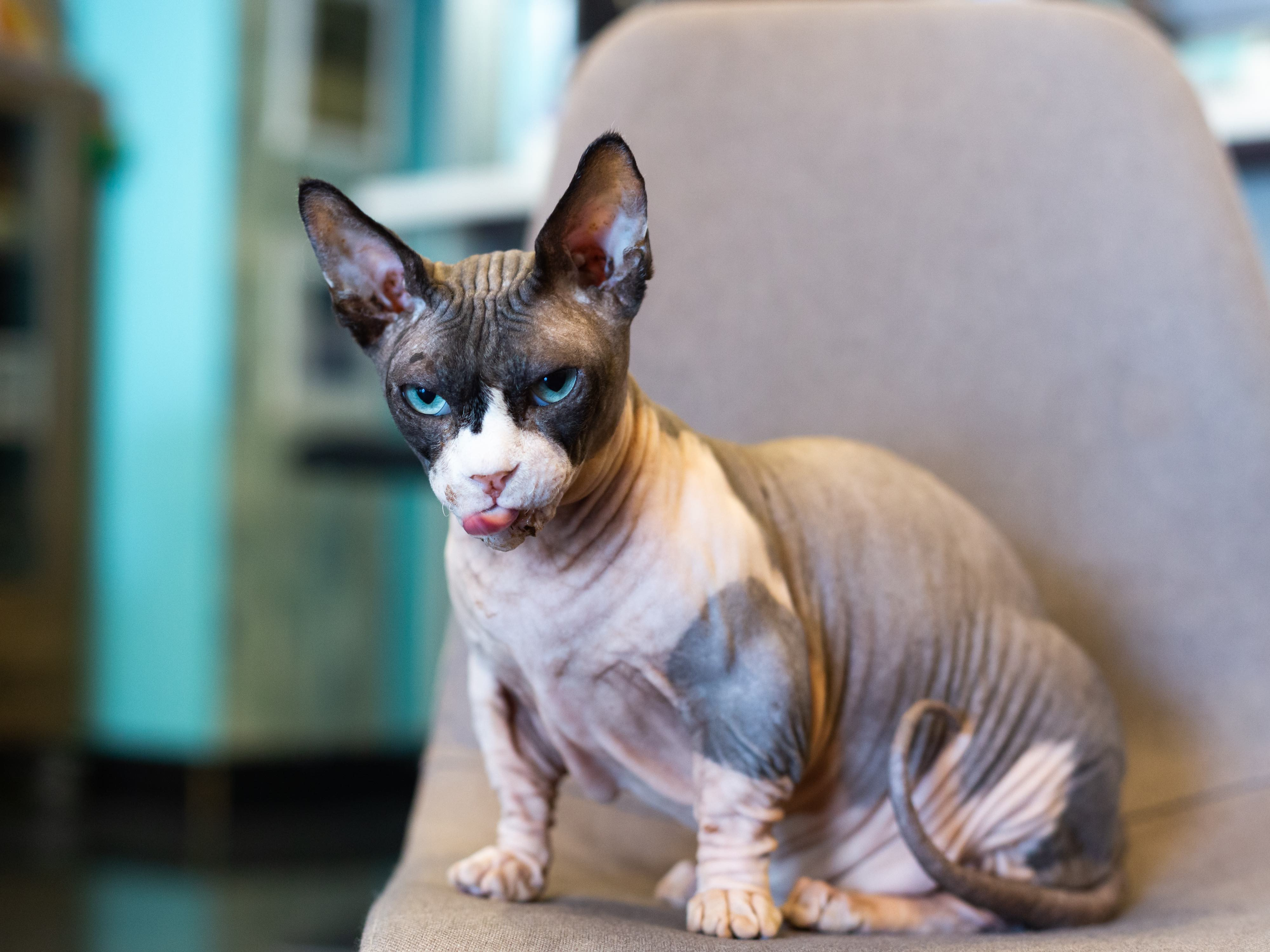 pink and gray bambino cat licking his lips
pink and gray bambino cat licking his lips
Photo credit: Adobe Stock/Anne Richard
The Bambino is a relatively new and captivating addition to the hairless cat family, first appearing in 2005. This breed is still considered “experimental” by the Cat Fanciers Association, adding to its unique appeal. The Bambino is a delightful cross between the hairless Sphynx and the short-legged Munchkin, resulting in a hairless cat with adorably short legs. This combination gives them a distinctive, low-to-the-ground profile and enhances their playful, kitten-like appearance even in adulthood. Bambinos are known for their affectionate and people-oriented nature, craving interaction and attention from their families. They thrive on playtime and mental stimulation, making them ideal companions for active households. If you’re considering a Bambino, be prepared for a higher price tag, reflecting their rarity and unique traits, typically ranging from $2,000 to $2,800. It’s also important to be aware that their Munchkin lineage means they may be predisposed to joint issues due to their shortened legs.
3. Peterbald: The Elegant and Energetic Russian Hairless
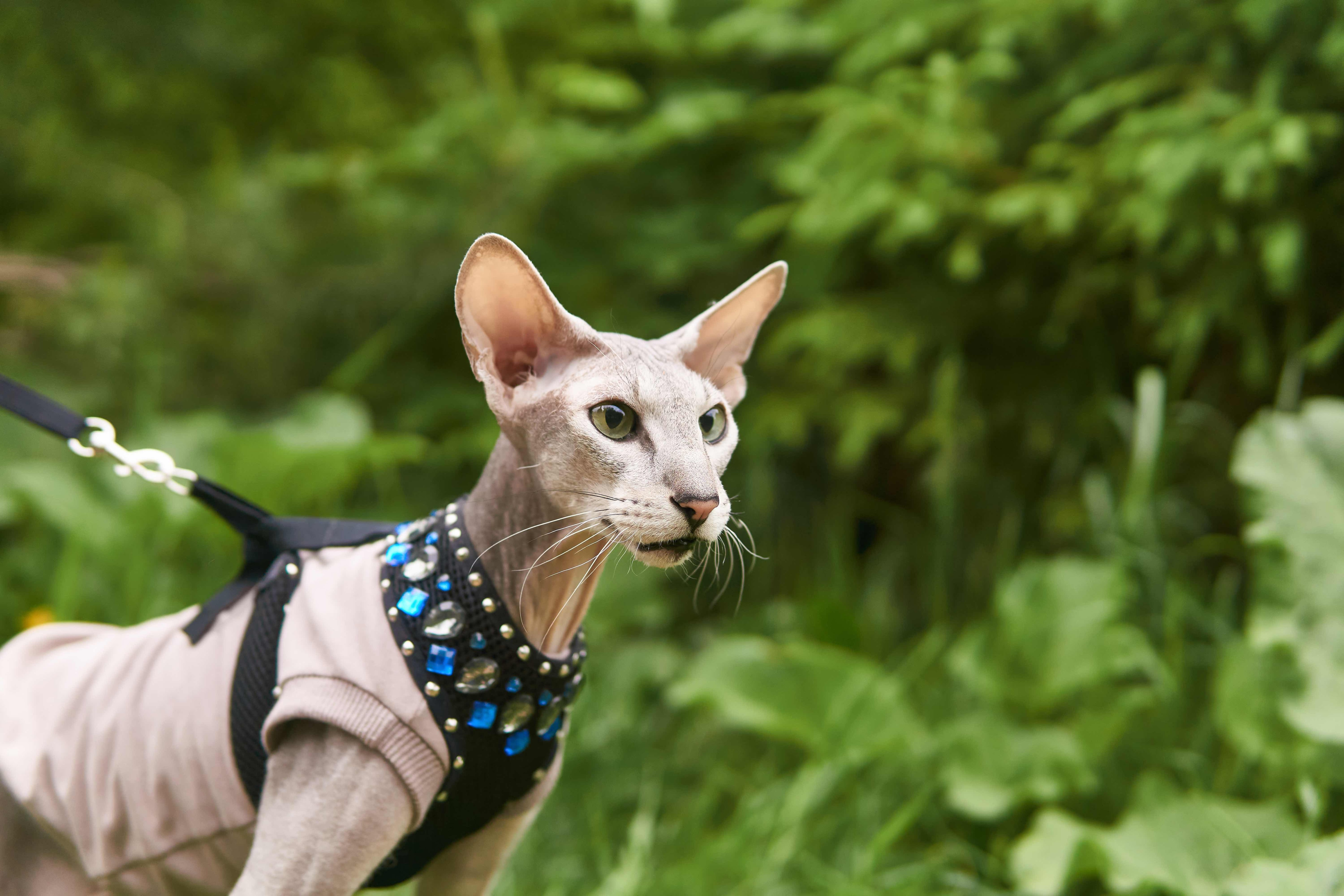 gray peterbald cat wearing a sweater on a leash
gray peterbald cat wearing a sweater on a leash
Photo credit: Adobe Stock/Evgeny
Originating from Russia, the Peterbald is a striking hairless breed characterized by its large, pointed ears that seem disproportionately large for its refined, wedge-shaped head. Peterbalds are relatively rare outside of Russia, adding to their exotic appeal. They are known for their friendly, outgoing personalities and boundless energy. These intelligent cats enjoy interactive play, often engaging in games of fetch and eagerly following their owners around the house, showcasing their loyal and companionable nature. Interestingly, “hairless” in Peterbalds is a spectrum. They can range from completely hairless to possessing a fine, fuzzy coat, a curly coat, or even a wiry coat of varying lengths. Some Peterbalds may even develop a coat similar to typical short-haired or long-haired cats, highlighting the genetic diversity within the breed.
4. Donskoy: The Versatile and Intelligent Hairless Companion
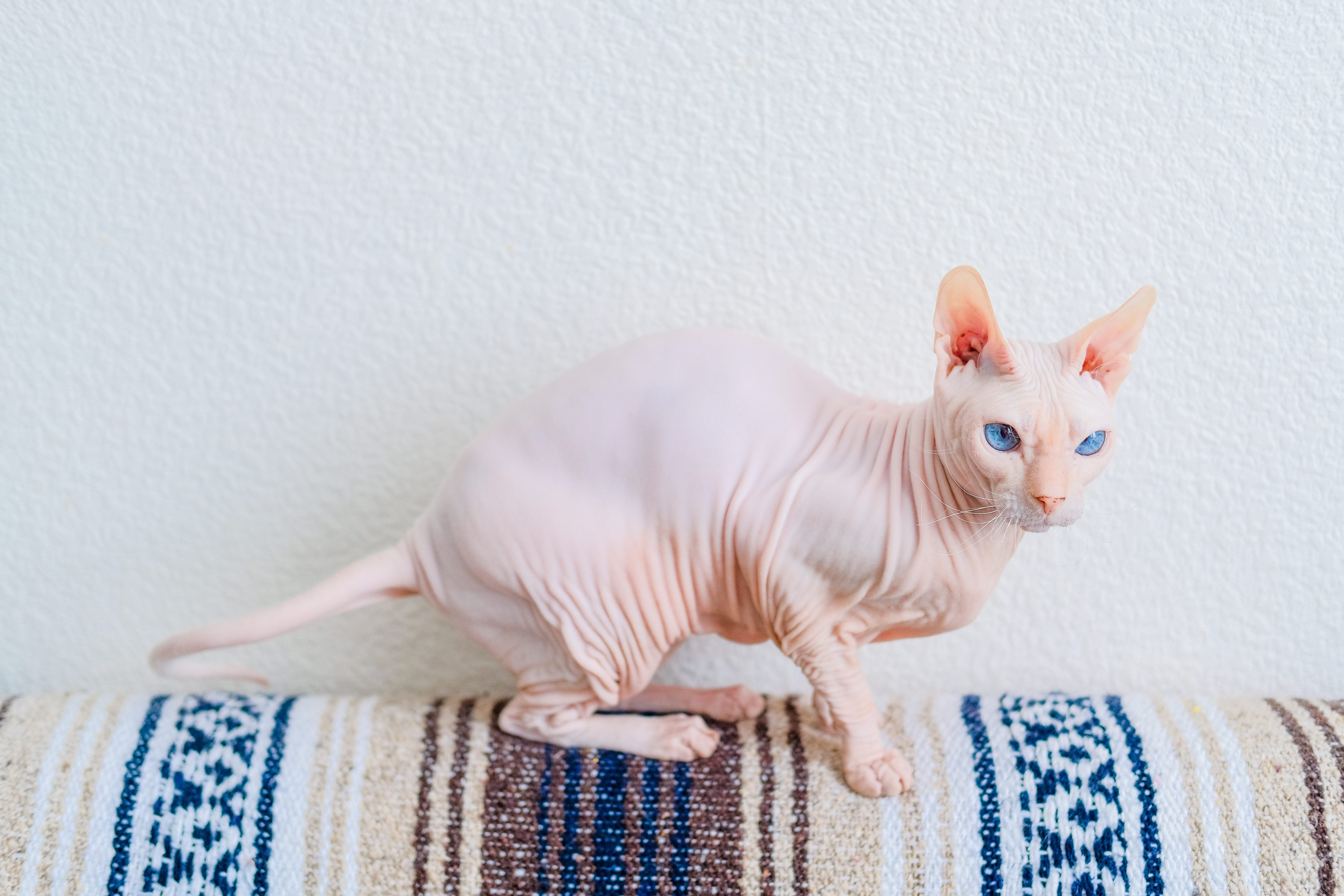 pink hairless cat with blue eyes perched on the back of a couch
pink hairless cat with blue eyes perched on the back of a couch
Photo credit: Adobe Stock/yolya_ilyasova
The Donskoy, also from Russia, presents another fascinating variety of hairless cat, distinguished by its diverse coat variations. Donskoy cats come in four primary types, each with a unique coat description:
- Rubber Bald: These Donskoys are born completely hairless and remain so throughout their lives, offering the most “classic” hairless appearance.
- Flocked: Born with a soft, downy coat resembling peach fuzz, flocked Donskoys may retain this coat or gradually lose it, becoming bald over time.
- Velour: Velour Donskoys are born with a bald patch on their head, a distinctive characteristic.
- Brush: Brush Donskoys have wiry, sparse hair across their body with noticeable bald patches, creating a unique textured appearance.
Beyond their varied coats, Donskoys are celebrated for their sweet and intelligent personalities. They are known to be excellent family pets, adapting well to homes with children and other animals, making them versatile and affectionate companions.
5. Lykoi: The Intriguing “Werewolf Cat”
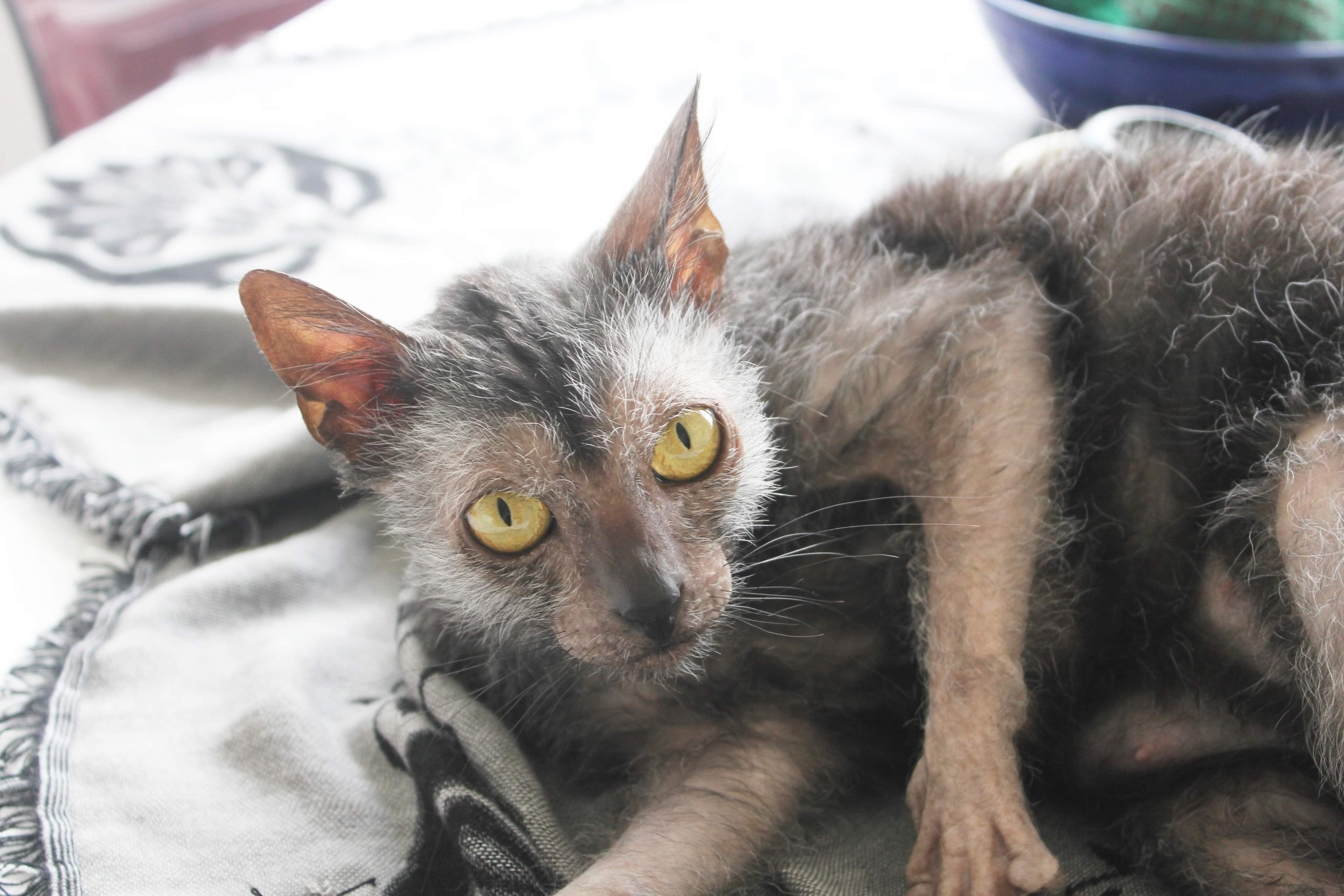 gray lykoi cat lying on his side and looking at the camera
gray lykoi cat lying on his side and looking at the camera
Photo credit: Angela Emanuelsson/iStock / Getty Images Plus via Getty Images
The Lykoi, often nicknamed the “werewolf cat” due to its sparse and unique coat, is a relatively new and captivating breed. The Lykoi’s coat is characterized by its patchy hair distribution, resembling the appearance of a werewolf. They are known for “wolfing out,” a phenomenon where they molt their sparse coat periodically, further enhancing their distinctive look. When they do have fur, it is surprisingly soft, making cuddle time particularly enjoyable. Owning a Lykoi is a unique experience that comes with a higher price point, with kittens typically starting around $1,000, reflecting their rarity and striking appearance.
6. Ukrainian Levkoy: The Hairless Cat with Folded Ears
 hairless ukrainian levkoy kitten standing in front of a window backdrop
hairless ukrainian levkoy kitten standing in front of a window backdrop
Photo credit: Adobe Stock/Светлана Валуйская
The Ukrainian Levkoy stands out as a hairless breed with distinctive folded ears, a trait it shares with its close relative, the Scottish Fold. Established in 2004, the Ukrainian Levkoy is a relatively young breed, and its long-term health is still being studied. However, the Scottish Fold’s predisposition to joint and cartilage problems suggests that Ukrainian Levkoys may also be at risk for similar health issues. The folded ears are a highly sought-after trait, increasing the kitten’s price, often reaching $2,000. However, not all Ukrainian Levkoys inherit the folded ear gene. Regardless of their ear type, Levkoys are often described as stoic and independent cats who appreciate quiet companionship and may enjoy the company of others without demanding constant attention.
Essential Care for Your Hairless Cat
Bringing a hairless cat into your home means understanding their unique needs. Their lack of fur makes them more vulnerable to sunburn and less able to regulate their body temperature compared to their furry counterparts. Protecting them from the elements is key. Sunscreen formulated for pets, UV-protective window films, cooling mats during hot weather, and cozy sweaters in the winter are essential to ensure their comfort and well-being.
Hairless cats also tend to have oilier skin, requiring a different approach to grooming. While they might seem like they need frequent baths, over-bathing can actually dry out their skin. Consult with your veterinarian to establish a suitable skincare routine. This might involve regular gentle wipe-downs with a damp cloth or occasional baths using specialized shampoos designed to replenish their skin’s natural oils. Furthermore, their ears and nails tend to accumulate more wax and oil buildup, necessitating more frequent cleaning to prevent infections and maintain their hygiene.
Hairless Cat FAQs
Are hairless cats truly hypoallergenic?
While no cat is completely hypoallergenic, hairless cats are often considered better choices for allergy sufferers. Cat allergens are found in saliva, urine, and dander, not just fur. However, hairless cats produce less dander, which can reduce allergen levels in the environment. If you have allergies, consult your doctor before bringing any cat home, and consider spending time with a hairless cat to assess your reaction.
What is the cost of a hairless cat?
Due to their relative rarity and specialized breeding, hairless cats typically cost more than many standard breeds. Expect to pay between $1,000 and $2,000 for a hairless kitten. Adopting a hairless cat from a shelter is less common, but specialized breed rescues may occasionally have hairless cats available for adoption.
Are hairless cats friendly and affectionate?
A hairless cat’s temperament is largely influenced by socialization, just like any other cat breed. Early socialization to people, other pets, and various environments is crucial for developing a well-adjusted and friendly cat. With proper socialization and positive reinforcement, hairless cats can be just as loving, affectionate, and playful as any other feline companion.
WRITTEN BY: Janelle Leeson – Freelance Writer (Re-written and expanded by solcat.net Content Creator)

